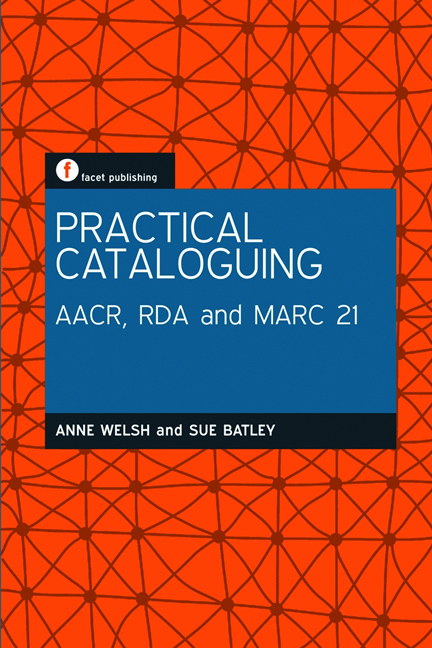Book contents
- Frontmatter
- Dedication
- Contents
- Acknowledgements
- Preface
- 1 Catalogues and cataloguing standards
- 2 The FRBRization of the catalogue
- 3 Bibliographic elements
- 4 Access points and headings
- 5 RDA: resource description and access
- 6 AACR and RDA
- 7 MARC 21
- 8 Practical cataloguing: bringing it all together
- 9 The birth of RDA and the death of MARC?
- 10 Examples
- References
- Index
3 - Bibliographic elements
Published online by Cambridge University Press: 08 June 2018
- Frontmatter
- Dedication
- Contents
- Acknowledgements
- Preface
- 1 Catalogues and cataloguing standards
- 2 The FRBRization of the catalogue
- 3 Bibliographic elements
- 4 Access points and headings
- 5 RDA: resource description and access
- 6 AACR and RDA
- 7 MARC 21
- 8 Practical cataloguing: bringing it all together
- 9 The birth of RDA and the death of MARC?
- 10 Examples
- References
- Index
Summary
A bibliographic description, whether created using AACR2, RDA or any other set of cataloguing rules, is composed of a series of individual bibliographic elements. As well as telling the catalogue user the title of a work and who created it, for example, some of those elements specify and describe the physical manifestation of the item.
This means that the publication format of the item being described influences the content of parts of the catalogue record. One of the primary drivers for the change in cataloguing standards is the proliferation of new physical storage media and eformats, which have led to challenges to accommodate them in bibliographic description.
Format first
Many of the issues encountered in AACR2 stem from its being based upon precomputer age principles (mainly to suit the card catalogue). Critics charge it with placing too much emphasis on publication format – and, indeed, following a general section that outlines general principles applicable to any and all formats (Part I1), the rest of Part I is taken up with rules relating to specific formats:
1 General Rules for Description 1-1
2 Books, Pamphlets, and Printed Sheets 2-1
3 Cartographic Materials 3-1
4 Manuscripts (Including Manuscript Collections) 4-1
5 Music 5-1
6 Sound Recordings 6-1
7 Motion Pictures and Videorecordings 7-1
8 Graphic Materials 8-1
9 Electronic Resources 9-1
10 ThreeDimensional Artefacts and Realia 10-1
11 Microforms 11-1
12 Continuing Resources 12-1
13 Analysis 13-1
(Joint Steering Committee for the Revision of AACR, 2005)This structure means that before cataloguing an item we have to decide what format it takes, and then apply rules from the relevant sections of AACR2. For example, a paperback edition of the latest Dan Brown thriller is catalogued following I1 (General Rules) and I2 (Books, Pamphlets, and Printed Sheets), while the video of his first blockbuster, The Da Vinci Code, is catalogued following I1 and I7 (Motion Pictures and Videorecordings). Cataloguers quickly get into the habit of following this structure, which can be summed up as follow I1 (General Rules) except when you are instructed to do something else in a later, formatspecific section.
- Type
- Chapter
- Information
- Practical CataloguingAACR, RDA and MARC 21, pp. 17 - 48Publisher: FacetPrint publication year: 2012



